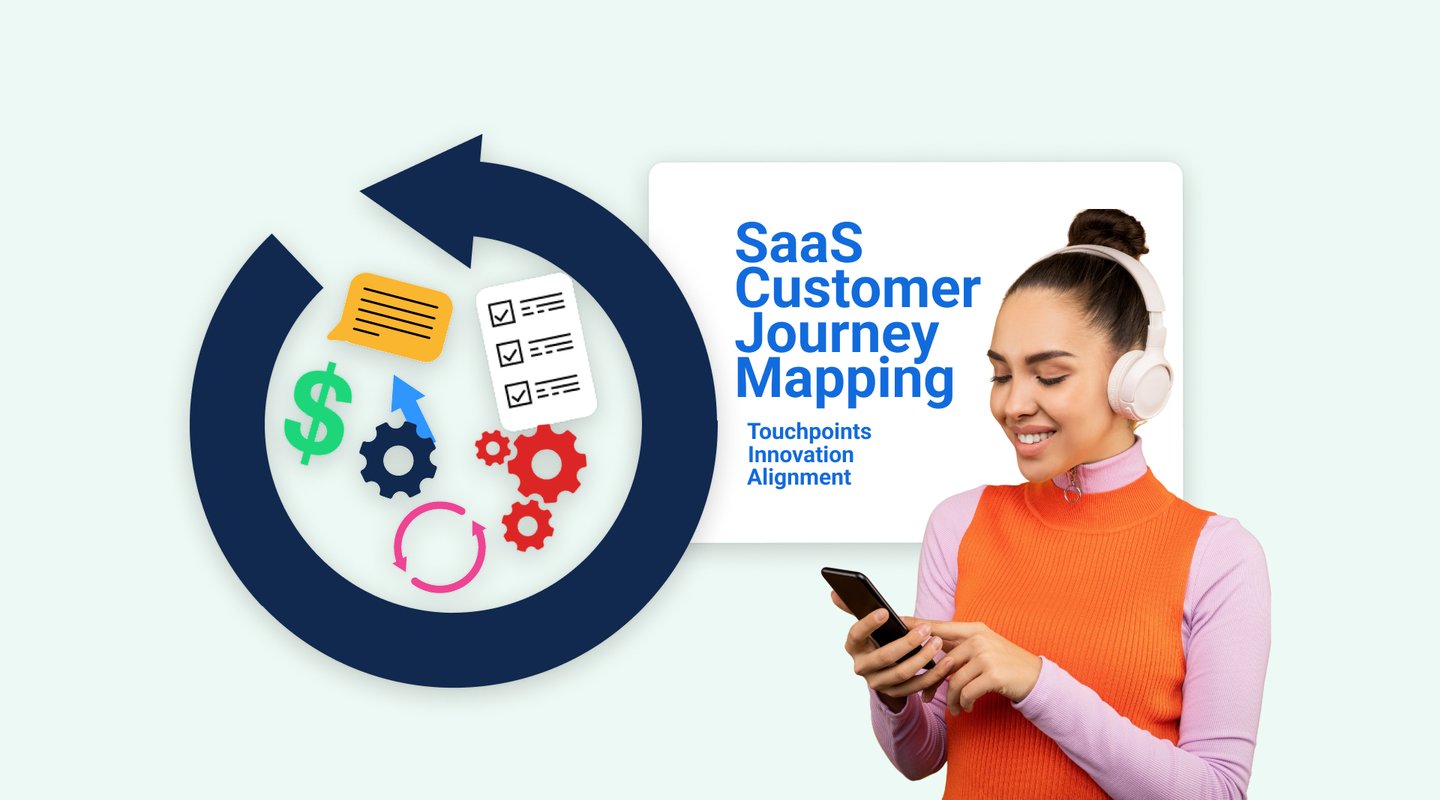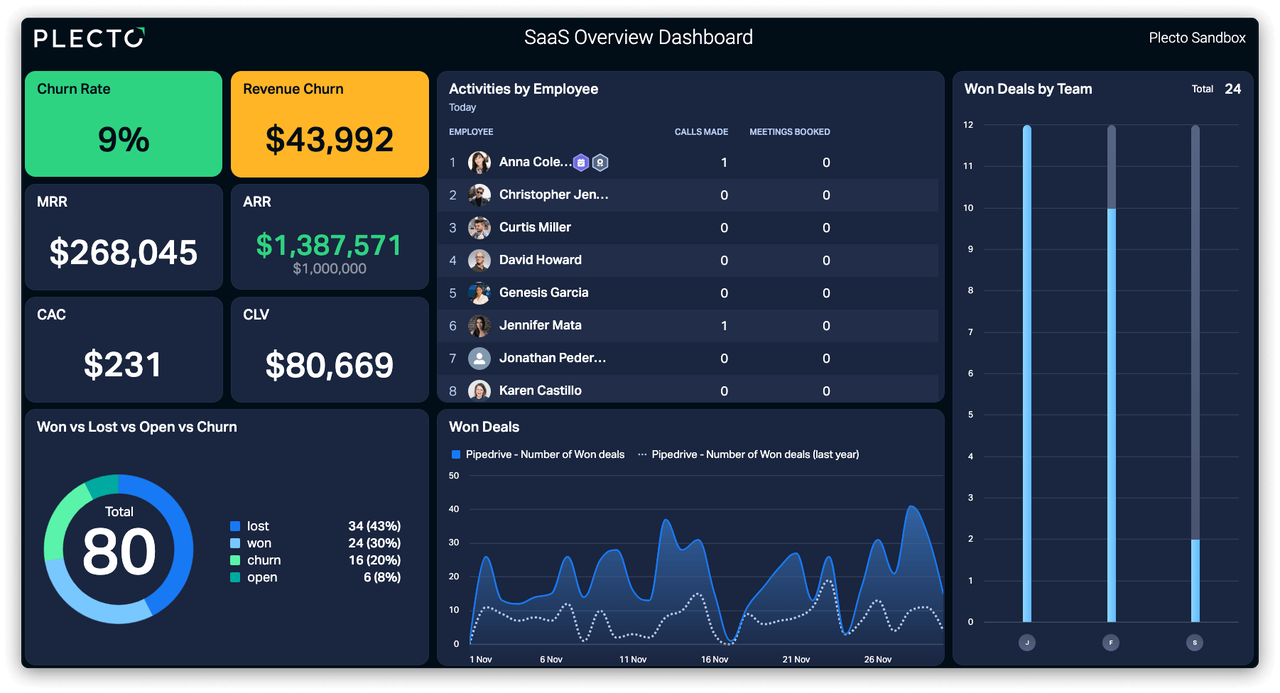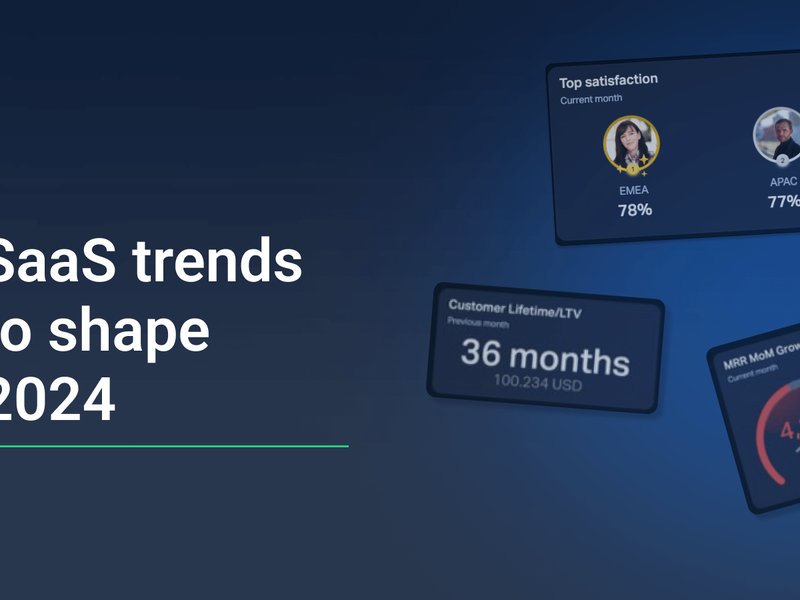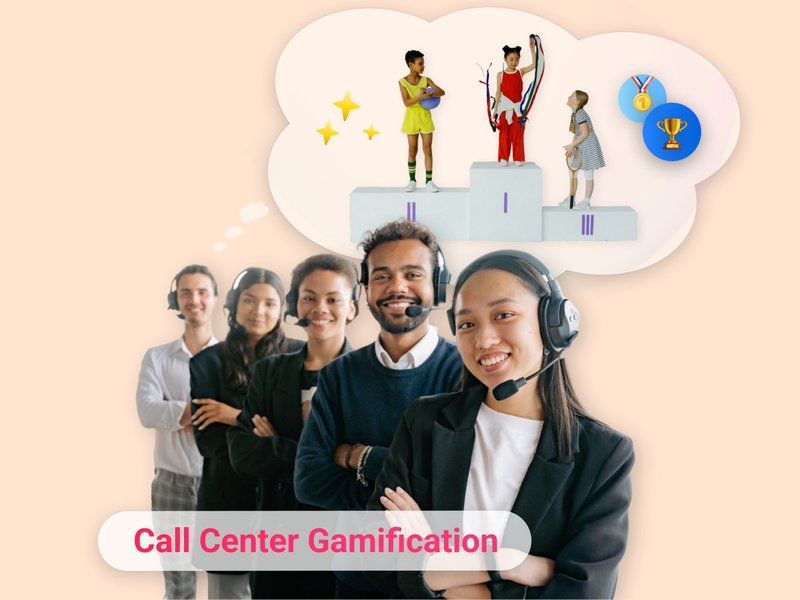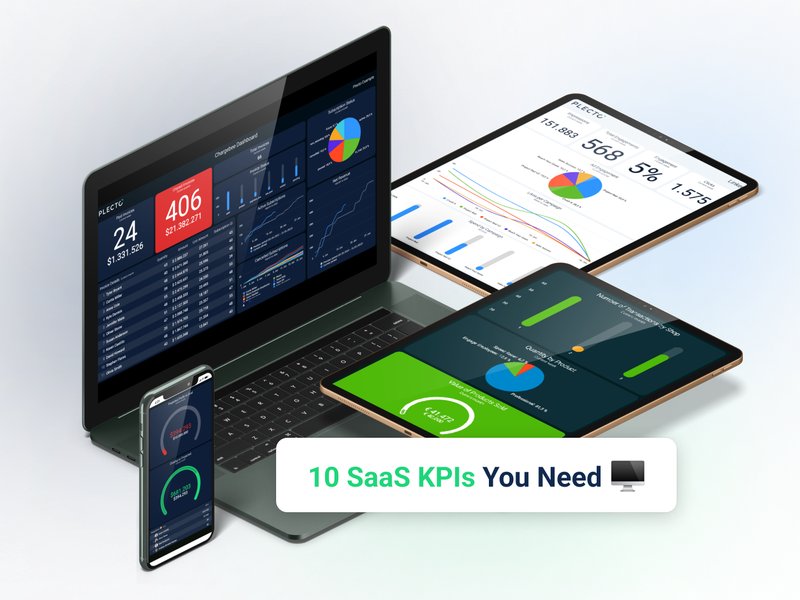SaaS companies are increasingly turning to customer journey maps to understand how customers buy their software products.
This article will help you understand the nuts and bolts of what a SaaS customer journey map is, why it’s beneficial, how it can drive innovation, and why it’s an important tool for tying together marketing, CS, and more!
What is a SaaS customer journey map?
A SaaS customer journey map is a visual representation of how potential customers interact with a company and its software products every step of the way – from the moment they enter the sales funnel until they (hopefully) become brand ambassadors. It usually includes typical customer experiences and encounters with a company as well as what should happen at each stage to ensure a positive outcome. Some companies take it one step further by also documenting possible blockers that could cause a customer to churn or not purchase at all – and how to mitigate these issues to keep customers moving freely through the steps to becoming loyal customers.
Ideally, a customer will purchase software, renew their subscription, and recommend the software to others. On the flip side, not getting the right pre-sales support could lead a prospect to choose another solution – or onboarding difficulties and poor customer support could mean that they won’t renew their subscription. A SaaS customer journey map lays out all of these possibilities to give companies the best chance of winning, retaining, and upselling customers.
6 Stages of a Typical SaaS Customer Journey
A typical SaaS customer journey isn’t much different from customer journeys in other verticals. However, there are thousands of SaaS solutions to choose from – and your company’s success hinges on its ability to effectively guide potential customers toward choosing your software and then keeping them happy with their decision.
SaaS customer journey maps can be worth their weight in gold because if you can understand your customers’ needs well enough to serve them the information that will demystify this typically high-involvement purchase and make their lives easier, you’ve got a customer for life! A customer journey map will help you communicate your product’s benefits in a way that aligns with the specific problem(s) each customer is trying to solve, and then ensure that your software continues to live up to its promises.
Like other industries, a SaaS customer journey map generally includes six stages.
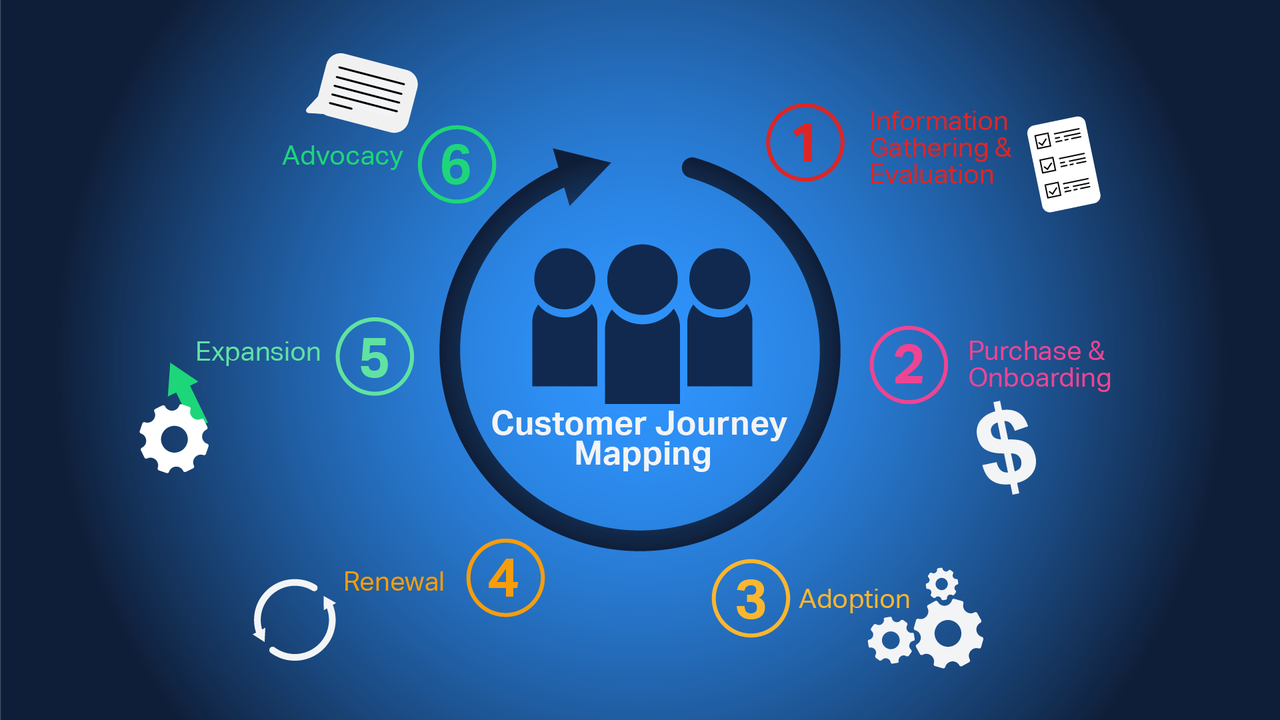
Stage 1: Information Gathering & Evaluation
In the information gathering and evaluation stage, a customer has identified a pain point and is gathering information about possible solutions. This is where they first become aware of a product, visit the company’s website, and begin evaluating their options. They might also sign up for a free trial. At this point, they’re a solid inbound lead.
Stage 2: Purchase & Onboarding
Getting this stage right is key to retaining customers. Now the customer has purchased the software and has started using it at the most basic level. This includes things like creating their account or profile and exploring the product's functionality, navigation, etc.
Stage 3: Adoption
This is where the rubber hits the road! In the adoption stage, the customer has incorporated the software into their daily work and is hopefully seeing its benefits.
Stage 4: Renewal
At this pivotal in the customer journey, the customer has been using the software for a significant period and their subscription is up for renewal. If they've had a positive experience and the product has eased their pain points, they'll probably renew. If they've had too many challenges and not enough support or the product is a bad fit, it's probably "sayonara!"
Stage 5: Expansion
This is where upsells happen. The customer is satisfied with what the software can do, they’ve renewed their subscription, they’re keen to access even more functionality, and they’re (hopefully) willing to pay for advanced features and upgrades.
Stage 6: Advocacy
The advocacy stage is the holy grail of the SaaS customer journey map. This is where companies reap the rewards of their efforts to optimize the customer journey. Here, the customer completes their journey by becoming a loyal and long-term user of the software and recommending it to others. They’ve become a brand ambassador!
Each of these stages builds on the previous stage. Each positive experience improves the chances that a customer will advance to the next stage of your SaaS customer journey map and eventually become a brand ambassador and started to make your brand name and logo design famous!
What should a SaaS customer journey map include?
If you’re starting from scratch, a good first step is to create a handful of personas that include things like demographics, pain points, business needs, expectations, typical purchasing timeline, and budget. Keep in mind that SaaS customers often have several stakeholders involved in decision-making and even more who are actually using the software — some of these personas will pop in and out of the process and may not be involved throughout the complete journey. Consider this non-linear process as you define your personas.
Once you understand who your typical customers are, you can create an initial SaaS customer journey map that documents the current customer experience at each stage. Here are some suggestions for information you’ll want to document for each persona at each stage in the customer journey:
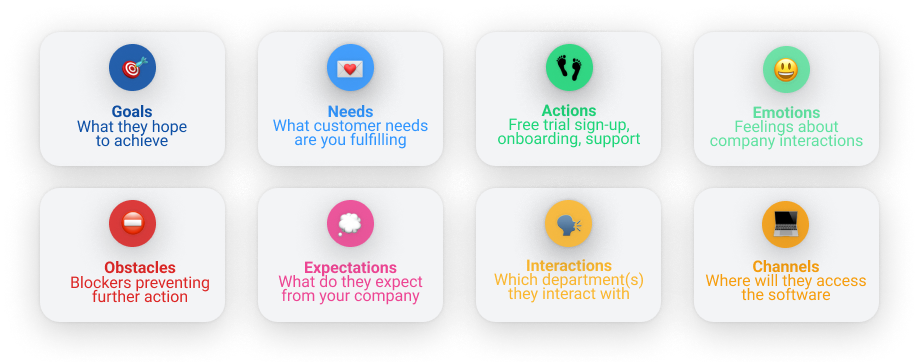
After some analysis, a beneficial next step would be to map the ideal experience. From there, you can define processes and service enhancements to help move your company toward facilitating the ideal customer experience.
How can a SaaS customer journey map improve the customer experience?
Today’s customers expect a customer-centric experience, and a SaaS customer journey map is one of the most effective tools for achieving this. Creating a solid map will enable you to proactively manage each stage of your customer's interactions with your company and its software — and develop standard operating procedures to streamline workflows. Once you clearly understand the optimal customer experience at each step, you’ll be able to develop and automate procedures that can lead to more customer-centric service — and successful outcomes.
For example, detecting that a prospect or customer has stalled in the evaluation, onboarding, or renewal stages of the customer journey can trigger a reminder message or an email containing links to an appropriate knowledge base, FAQs, tutorials, or other helpful support resources. For more inspiration on how you can provide a better customer experience, check out this article that focuses on incorporating email marketing for a smoother customer journey!
Aside from its obvious operational value, a SaaS customer journey map can help you gain a deeper understanding of product-market fit and the main attributes of your most successful customers and their needs. This can help ensure that you’re marketing to the right demographics and attracting relevant prospects who are likely to find value in your software and become long-term subscribers and ambassadors.
Build your first dashboard.
Start your 14-day free trial today
4 Ways a SaaS Customer Journey Map Can Improve CS
With thousands of SaaS solutions to choose from, CS can be the differentiator that drives someone to choose your solution over a similar one from a competitor.
Here are four ways a SaaS customer journey map can improve CS to help you win and retain customers:
1 — Enables you to provide customer-centric service
Once you understand your customers’ needs and motivations, you can provide customer service that’s centred around their perspective. This makes customers feel heard and understood — and that their needs have been met. This is one of the golden rules of effective customer service in 2022.
2 — Enables you to provide customer-centric service
Once you’ve stepped into your customers’ shoes, it’s easier to identify opportunities for improving service, support, and the overall customer experience. Maybe your onboarding process is lacking tutorials or perhaps alternative support channels like live chat, chatbots, or self-service tools could reduce support costs and wait times while boosting customer satisfaction metrics. Updating your customer journey map based on real-world data will help you identify stages that could use some attention.
3 — Identifies touchpoints to help predict future behavior and needs
Mapping the customer journey using the information you’ve already collected can help you identify who your customers typically interact with along in their journey – and why. This information can help you respond proactively by anticipating future behavior and needs. It can inform decisions around future software enhancements, potential upgrades, and how to provide more proactive and comprehensive customer support.
4 — Helps pinpoint opportunities for future software enhancements/upgrades
Once you understand how your customers are using the software, the value they get from it, and where they usually run into challenges, you can create a shortlist of future upgrades to improve product-market fit. Keep a log of feature requests, including the specific customers who have made the request – so you can determine how many want the feature. When it comes to future software updates, you’ll be able to prioritize the components that have been requested the most and even send out alerts to these customers (or lost prospects) to renew their interest in your product or service.
Taking an informed, customer-centric approach to future software development almost guarantees you’ll be investing in the right features and upgrades – and not continuing to invest in those that are under-used. When your customers feel like you’ve read their minds, or listened to their feedback, they’ll continue to find value in your product and be less likely to shop around.

Customer Journey Maps Improve Inter-Department Communication
Many companies are prone to working in silos – with no exceptions when it comes to SaaS companies. But research shows that interdepartmental collaboration can boost innovation by up to 15 percent! Innovation is the key to thriving in the hyper-competitive SaaS market, and customer journey maps are a great way to start improving communication, boosting innovation, and enhancing productivity – all of which will help drive better customer experiences.
A comprehensive SaaS customer journey map can facilitate effective communication between departments, affecting marketing decisions, sales tactics, customer service, and future development to ensure a world-class customer experience every step of the way. By understanding where customers first encounter your product and what they’re hoping to achieve, marketing will be able to develop targeted campaigns and sales will be able to sell (and upsell) more effectively. By understanding where customers might feel support and service are lacking, you’ll be able to roll out the right improvements. And finally, when you understand perceived gaps in functionality as well as ‘nice-to-have’ features, your product development team will be able to focus on delivering features and upgrades that will make a real difference to your customers
Take your SaaS customer journey map to the next level – with Dashboards!
Once you’ve carefully constructed your SaaS customer journey map, you’ll be able to understand your customer’s touchpoints, anticipate their needs, and provide next-level customer experiences.
To take your customer journey map up a notch, we recommend building a customer service dashboard or customer experience (CX) dashboard. These dashboards allow you to centralize and visualize key CS metrics to improve efficiency, identify challenge areas, and help your support teams deliver outstanding customer experiences.
Plecto integrates with the most popular CRM and support systems to help visualize and track key metrics related to important SaaS customer service activities, including ticketing systems, phone calls, satisfaction ratings, and more! Sign up for a 14-day trial and see what Plecto’s data visualization, gamification, and coaching tools can do to boost your motivation and outperform today!
